DIAMOND CLARITY
LEARN ALL ABOUT THE CLARITY OF DIAMONDS
This post contains affiliate links. If you use these links to buy something I may earn a commission. Thanks! As an Amazon Associate I also earn from qualifying purchases.
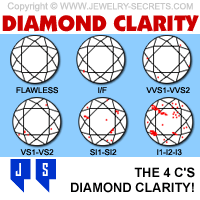
Diamond clarity is all about the amount of flaws and imperfections (called inclusions and blemishes) that a diamond has. The less flaws (or clarity characteristics), the cleaner the stone, the higher the clarity, quality and value becomes.
Almost all diamonds have some sort of flaws and identifying marks that make them unique in nature. These flaws form a fingerprint in the diamond and no two diamonds are alike.
Think about people born with birthmarks, moles, freckles… Everything born in nature has its own characteristics and it’s own identity.
Flaws can be many things; a black spot in the diamond, a chip on the girdle, a fracture running through the stone, a rough spot on a facet, a cloudy area in the pavilion, a pinpoint by the crown…
Flaws can be internal (inside the diamond, called inclusions), or they can be external that come to the surface or outside of the stone, called blemishes.
Take a quick glance at the picture below for the 6 different clarity grades.
Diamond Clarity Grades

For a diamond to be considered truly flawless, both the internal and external of the diamond has to be free of inclusions and blemishes under a 10x powered microscope.
The odds of these are extreme. Flawless diamonds are almost impossible to find and even if you did see one, chances are you wouldn’t like the cut or color. Usually with nature it’s a give and take. Strong in one area, weak in another.
As a comparison, a one carat (1.00) diamond (as of this writing on James Allen), ideal cut, G color, flawless diamond is valued at $14,879. While a one carat, ideal cut, G colored, SI1 clarity diamond is going for $7,094.
| CARAT, CLARITY, COLOR, CUT, POL, SYM, FLUOR | PRICE | VIEW |
| 1.00, FL, G, EX, EX, EX, NONE | $8,700 | VIEW |
| 1.00, SI1, G, EX, EX, EX, NONE | $5,200 | VIEW |
That’s a huge increase for flawless! Worth it? Sure, but keep in mind that the only differences between these two are tiny, microscopic flaws. Meaning, if you don’t use a microscope or a 10x jeweler’s loupe, you won’t see the difference. Personally, I’d rather spend my money on something I can see a visible difference in, like a bigger carat weight or a better color.
Most diamonds on the market have flaws. In fact, half of the market is made up of diamonds with inclusions so big, that you can even see them with the bare eye (no loupe or microscope needed).
Let’s take a closer look at the different types of imperfections and then we’ll talk about how they affect clarity…
Inclusions and Blemishes
Below are the types of inclusions and blemishes that determine what clarity grade a diamond gets. This clarity grade depends on a number of factors: the number of flaws in the diamond, the size of the inclusions, their position, their color and the nature of their characteristics.
Inclusions
There are many types of internal flaws. They are…
Feathers
A feather can be any type of break or crack in the stone. It’s called a feather because it generally has a white appearance like a feather. This can happen when the diamond was growing, or if the diamond is hit hard enough.
Feathers are normally of two different types: cleavages and fractures.
Cleavages
Cleavages are usually a break in a weak spot in the diamond.
Fractures
Fractures are many jagged breaks in different directions.
Bearded Girdle
A bearded girdle is when the diamond has small hairline breaks or fractures that surround the outside edge (the girdle) of the diamond. This can be caused when the diamond was cut, or it could be caused from years of wear and tear. A lot of older diamonds and estate diamonds often have bearded girdles. It’s wise to scope them with a loupe before purchasing.
Cavity
A cavity is exactly what it sounds like; a hole in the diamond usually caused by the cutting process (kind of like pulling a knot out of a tree).
Bruise
A bruise is a small fracture in a diamond usually caused by a quick, sharp blow.
Chips
Chips are small chunks taken out of the diamond, usually on the crown or girdle of the diamond (the part of the diamond that gets the most abuse). A chip is caused by the right amount of force (a sudden strike), at just the right angle.
Grain Lines
Grain lines are like rings in a tree. Graining is irregular growth patterns that show up in the diamond. Often they will look like ripples or waves in the stone.
Cloud
A cloud is a foggy or cloudy area in the diamond that’s caused by a lot of small inclusions all grouped together.
Crystal
Crystals are other rocks or minerals that get embedded or trapped inside the diamond when the diamond was formed or brought to the surface of the earth.
The interesting thing about crystals is that many crystals found in a diamond are actually pieces of diamond that crystallized differently than the rest of the stone.
A lot of crystals are dark and stand out like a sore thumb. These crystals are commonly called carbon spots or black carbon spots. They are a diamond’s #1 inclusion!
Laser Drill Hole
A laser drill hole is a hole or tube left behind after a diamond has been laser drilled (clarity enhanced) to remove or burn out a sightly inclusion.
Pinpoint
A pinpoint is a small, tiny crystal that looks like little, bitty dots in the stone.
Blemishes
Now we move onto the flaws that show up on the outside or surface of the stone…
Knot
A knot is a crystal that is exposed to the surface of the diamond usually through the cutting process.
Extra Facet
Extra facets are usually facets that are added to a diamond to remove an inclusion or flaw that sits close to the outside or girdle of the diamond. Extra facets are common and will help raise the clarity grade of the stone (because it removes the flaw).
As long as the extra facet is small and around the girdle (or underneath it), it won’t affect the beauty or value of a diamond.
Abrasion
An abrasion is where the sharp knife edges of the facets (where they meet) get worn down or rounded away through normal wear and tear or by the cutting process.
Natural
A natural is part of the original diamond that didn’t get cut or polished like the rest of the stone. Usually naturals are on the diamond girdle and often these naturals contain a very cool triangular growth pattern called trigons. :)
Nick
A nick is a small chip taken out of the girdle or facet. Usually this is caused by hitting the diamond with brute force or pressure.
Polish Lines
Polish lines are Lines that are left on the surface of the stone by irregular polishing.
Pit
A pit is a small opening on the surface of the stone, usually looking like a pinpoint, but coming to the outside of the diamond.
Polish Marks
Polish marks are burnt areas on the surface of the stone caused by too much polishing.
Rough Girdle
Rough girdles are rough, grainy spots on the girdle caused by bad polishing.
Scratches
Scratches are scratches on the outside of the diamond usually caused by the polisher or rubbing up against another diamond.
Grain Lines
Grain lines are waves or ripples that appear on the facets of a diamond. This is usually caused by irregular growth patterns.
11 Different Clarity Grades
As you can see, there are many types of inclusions (many man-made) that can come in all different shapes and sizes. Some are rather obvious, like fractures and carbon spots, others are hard to see, like grain lines and naturals. But they all affect the clarity of the diamond and the price.
There are 11 different clarity grades in all. They range from flawless diamonds (FL) all the way down to 13 clarity diamonds where the inclusions get so big and so apparent they distract from the real beauty of the stone.
Take a look at the diamond clarity chart as devised by GIA. One thing to note about clarity is grades are usually determined by the biggest inclusion that’s visible first.
Diamond Clarity Chart
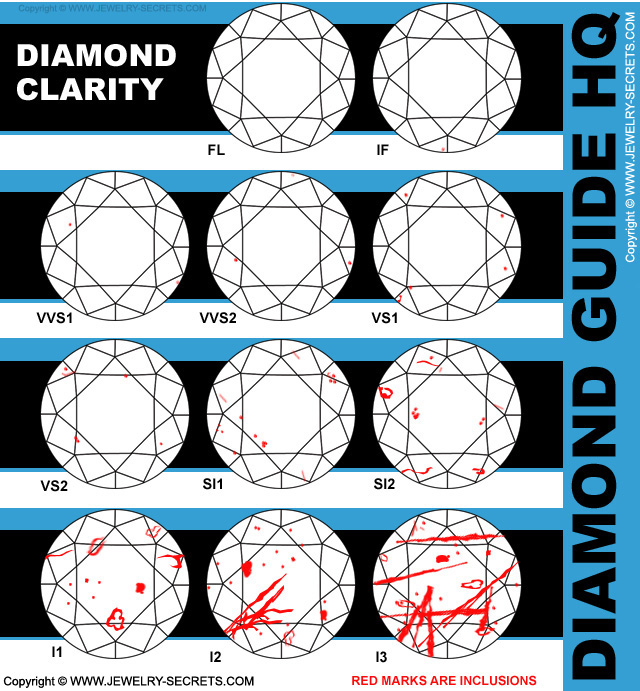
Let’s now see how each grade of clarity stacks up…
FL – Flawless
Flawless (FL) diamonds have no microscopic inclusions or blemishes in the diamond whatsoever. The interesting thing about flawless diamonds is the fact that they can still contain characteristics like extra facets, naturals or internal graining, as long as they aren’t apparent in the face up view and don’t distort the Diamond in any way.
See images below…
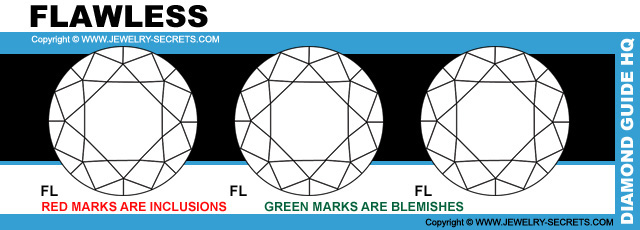
| CARAT, CLARITY, COLOR, CUT, POL, SYM, FLUOR | PRICE | VIEW |
| 1.00, FL, G, EX, EX, EX, NONE | $8,800 | VIEW |
IF – Internally Flawless
Internally flawless (IF) diamonds are internally free of any inclusions. but these diamonds may have some minor blemishes on the surface of the stone… As well as extra facets and naturals like flawless diamonds do.
See images below…
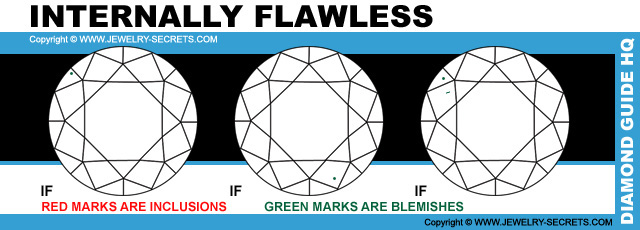
| CARAT, CLARITY, COLOR, CUT, POL, SYM, FLUOR | PRICE | VIEW |
| 1.00, IF, G, EX, EX, EX, NONE | $8,650 | VIEW |
VVS1 – Very Very Slightly Included 1
Very, very slightly included (VVS1) diamonds (level 1). Inclusions in VVS1 diamonds are so small and so minute that they are extremely difficult to locate under 10x (ten powered) magnification. Normally you would have to view a VVS1 diamond from the side view (pavilion) to see any flaws and even then, it is usually just a pinpoint or two.
See images below…
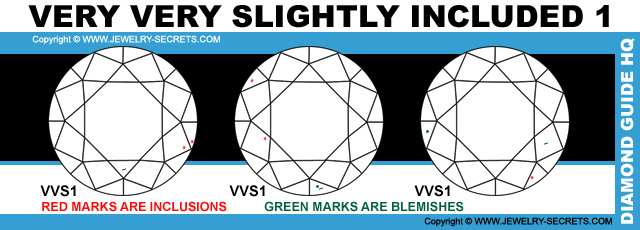
| CARAT, CLARITY, COLOR, CUT, POL, SYM, FLUOR | PRICE | VIEW |
| 1.00, VVS1, G, EX, EX, EX, NONE | $8,000 | VIEW |
VVS2 – Very Very Slightly Included 2
Very, very slightly included (VVS2) diamonds (level 2). VVS2 has very difficult to see inclusions in the stone. Anything in the VVS2 range or higher will look flawless to the average person. Only an expert with a trained eye can usually detect these small, very tiny identifying marks.
See images below…
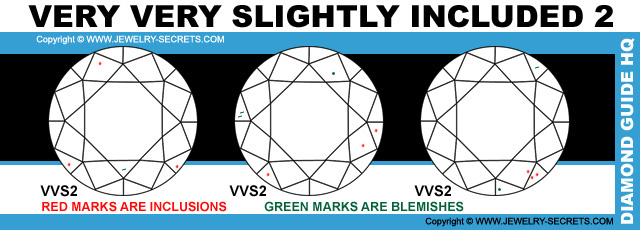
| CARAT, CLARITY, COLOR, CUT, POL, SYM, FLUOR | PRICE | VIEW |
| 1.00, VVS2, G, EX, EX, EX, NONE | $7,600 | VIEW |
VS1 – Very Slightly Included 1
Very slightly included (VS1) diamonds (level 1). VS diamonds are my favorite diamonds in the world. In VS1 clarity, the inclusions are still difficult to see under 10x magnification. If helped, most customers can spot these flaws and imperfections. It also helps if these marks are listed on a diamond plot (which we’ll get into later).
Inclusions get a tad bit bigger than those in a VVS clarity diamond. These inclusions range from crystals, clouds, pinpoints and feathers.
VS1 diamonds are beautiful, stunning and allow light to pass freely through the stone to enhance the sparkle and brilliance.
See images below…
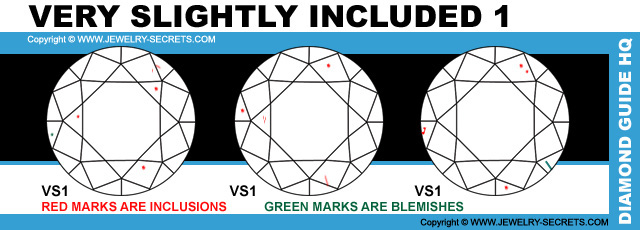
| CARAT, CLARITY, COLOR, CUT, POL, SYM, FLUOR | PRICE | VIEW |
| 1.00, VS1, G, EX, EX, EX, NONE | $7,500 | VIEW |
VS2 – Very Slightly Included 2
Very slightly included (VS2) diamonds (level 2) are very similar to VS1 diamonds. The only difference between level 1 and level 2 are the size and position of the inclusions. They get somewhat easier to spot under magnification and the Flaws may gravitate more towards the center of the stone, versus outside and underneath the facets.
What I love the best about VS diamonds (VS1 and VS2) is that the average person can spot these clarity characteristics under a microscope. Higher than that (VVS1 & VVS2), there is no real physical traits that people can identify with. VVS looks perfect. You could be looking at a man-made diamond or a diamond fake and never know it.
See images below of VS2 diamonds…
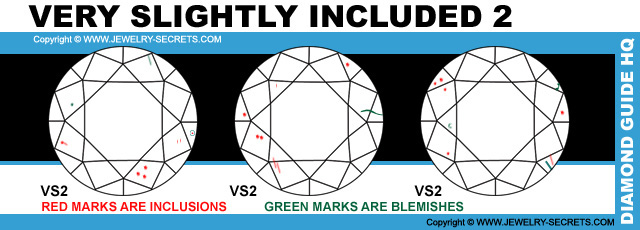
| CARAT, CLARITY, COLOR, CUT, POL, SYM, FLUOR | PRICE | VIEW |
| 1.00, VS2, G, EX, EX, EX, NONE | $6,400 | VIEW |
SI1 – Slightly Included 1
Slightly included (SI1) diamonds (level 1). Inclusions and flaws in an SI1 diamond will be easy to spot under 10x power. People have no problems seeing flaws like crystals, clouds, feathers and carbon spots under the scope.
SI1 is the lowest clarity grade that I would normally recommend because SI1 is the first grade of diamond where the inclusions become microscopic only. They can’t be seen with the bare eye (unless you have really awesome vision).
This is what makes SI1 such a great diamond. The diamond looks clean to the unaided eye, but you don’t pay an arm and a leg for it like you would with a VVS or VS diamond. SI diamonds are the easiest to identify under a microscope because the inclusions are easy to see and pick out. Anytime in your life you can view this diamond under a scope and see those same exact flaws. Doing this will keep you from getting ripped off. Being able to memorize and identify your flaws protects you and your diamond.
See images below…
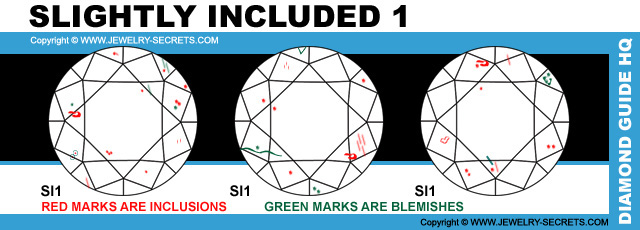
| CARAT, CLARITY, COLOR, CUT, POL, SYM, FLUOR | PRICE | VIEW |
| 1.00, IF, G, EX, EX, EX, NONE | $5,300 | VIEW |
SI2 – Slightly Included 2
Slightly included (SI2) diamonds (level 2). Inclusions in an SI2 diamond are very easy to see under a 10x powered loupe or microscope. Comparing an SI2 diamond up against a VS2 diamond can often be startling. It’s amazing how much bigger the inclusions get.
SI2 diamonds often have flaws so large that you can see these from the naked eye, but often, these inclusions are only seen when viewed from the side of the diamond (through the pavilion).
If you purchase an SI2 diamond as an engagement ring, be ready for your fiancé to be looking at her stone and say “Is that a crack?” or “I can see black spots in my stone“. Black marks, cracks, clouds and feathers are common in SI2 stones.
SI2 diamonds are the most questionable clarity of any grades. And that’s because it divides all the other grades into two groups, 1) inclusions that are microscopic, and 2) inclusions that you can see with the naked eye. Anything SI1 or higher is microscopic. Anything I1 or lower is eye visible.
When inclusions get so large that they are eye visible, they can’t help but stand out and get noticed. Once you see them you will always see them. The sad thing about eye visible inclusions are the fact that they can affect the beauty and sparkle of the diamond. Inclusions can stop light from entering and leaving the diamond, which makes the stone sparkle less and makes the Flaws stand out even more.
See images below…
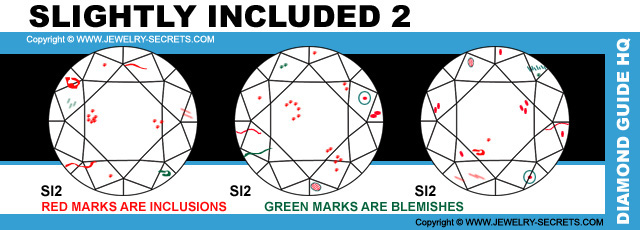
| CARAT, CLARITY, COLOR, CUT, POL, SYM, FLUOR | PRICE | VIEW |
| 1.00, SI2, G, EX, EX, EX, NONE | $4,100 | VIEW |
SI3 – Slightly Included 3
Slightly included (SI3) diamonds (level 3). Here’s some important info… There is no SI3 clarity! GIA (the founders of the 4C’s) do not recognize SI3 as a clarity grade. But, you will still find SI3 clarity on the market. Some other certification companies added SI3 into their grading just to smooth over the gap between SI2 and I1 clarity diamonds better. The only thing it does is confuse the public more and make I1 clarity diamonds sound better.
Walk into any jewelry store today and chances are if you look at their clarity grading charts you’ll see no SI3 clarity. It’s because those grading charts are GIA’s grading charts and just about every jeweler in America uses it to show, sell, purchase and price diamonds with. There is no SI3!
GIA doesn’t believe in this in between grade and will normally grade SI3 clarity diamonds as what they really are: I1 clarity diamonds. Note this if you are out pricing diamonds… You may be paying more for a diamond that sounds good (SI clarity), but it’s really an I clarity. You may be paying too much!
I would ignore all SI3 clarity diamonds until GIA recognizes them as an official grade and adds them to the diamond clarity charts.
I1 – Imperfect 1
Imperfect (I1) diamonds (level 1) (or included diamonds) have eye visible inclusions in them. These inclusions are usually quite striking. Cracks, black carbon spots, cloudy or foggy areas, fracture lines… Things you can actually see just by looking at the stone.
I clarity is usually not the right clarity grade for an engagement ring. Usually those are reserved for SI1 or higher.
Inclusions in an I1 clarity diamond are so significant, they can even affect the durability of the stone (the larger the flaws, the weaker a diamond becomes).
Viewing inclusions in an I clarity diamond can be shocking under magnification. Sometimes they’ll be so filled with flaws and debris that the whole diamond looks like a jigsaw puzzle.
I1 clarity is the highest of the I clarity group. If you must buy an I clarity diamond, get an I1 over all else. And then, it’s usually only because of price. I clarity diamonds are the most affordable diamonds out there… But you pay the price in quality and beauty.
See images below…
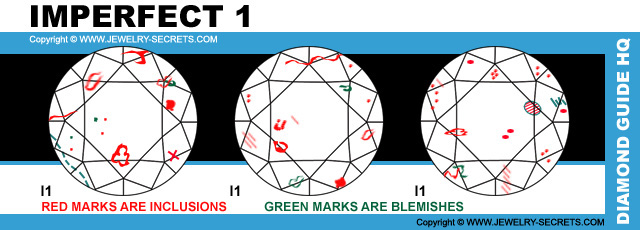
| CARAT, CLARITY, COLOR, CUT, POL, SYM, FLUOR | PRICE | VIEW |
| 1.00, I1, G, EX, EX, EX, NONE | $2,800 | VIEW |
I2 – Imperfect 2
Imperfect (I2) diamonds (level 2) (or included diamonds) have inclusions that get bigger and fill more of the stone. You’ll have no problems spotting these flaws, feathers, crystals, needles, cracks, fractures and carbon spots. Often these inclusions will be straight down in the diamond (right under the table, or top of the stone) where they hinder brilliance, sparkle and fire. These inclusions can’t hide and I’ll see people try to wipe the inclusions away like there’s dirt on the stone. It’s not… It’s in the stone and it’s in there for life.
Comparing an I2 diamond to an SI2 diamond is a huge leap. There’s a visible difference as well as a massive difference under the microscope. You’ll have to see it to believe it.
See images below…
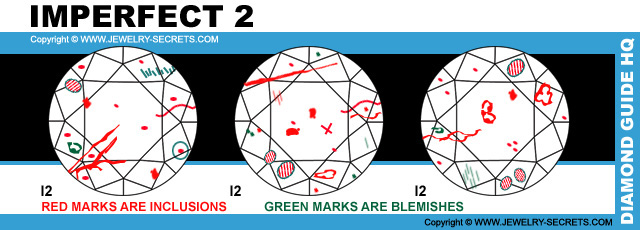
I3 – Imperfect 3
Imperfect (I3) diamonds (level 3) (or included diamonds) are the lowest clarity grade on the market. Below that are what they call industrial diamonds (that are used in dentist’s drills and for cutting other diamonds). I3 clarity compared to a VS clarity is like a night and day difference. It will blow you away. There is no comparison.
You will always find exceptional deals on I3 clarity diamonds because there is nothing lower. If you want a diamond, don’t care about quality or brilliance, I3 is the diamond to buy.
I3 clarity will often be so filled with flaws and imperfections that the entire stone will look cloudy and foggy like a huge chunk of salt.
Most I3 diamonds lack any sparkle and most are pretty brittle and can shatter with the right amount of strike or hit.
You even have to be careful when setting an I3 clarity diamond in a mounting because the internal flaws are weak and vulnerable.
Without the brilliance and shine to cover up their flaws like most diamonds have, flaws in an I3 stand out even more.
See images below…
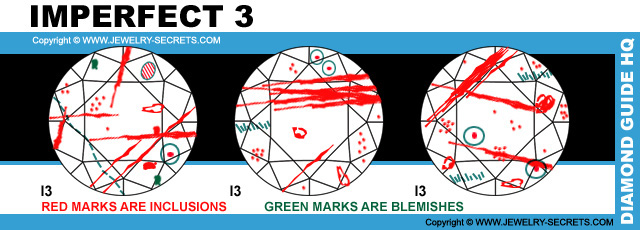
I clarity diamonds (I1, I2 & I3) do not make great engagement rings. Close scrutiny makes these flaws look unattractive and unappealing.
If you buy an I clarity diamond, make sure you microscope them well. Look at the stone from all angles and sides. Some I clarity diamonds are not that bad and face up well. Some people see the flaws in them, others do not. Every diamond is different and will have their own characteristics. You just have to see what you are willing to live with, and what you’ll be sacrificing. Beauty? Sparkle? Vulnerability? Only you can decide.
Viewing Inclusions
Reading about inclusions and actually seeing inclusions are two different things. You owe it to yourself to head on out to a jeweler near you and inspect some stones.
I always advise looking at a diamond in each of the different clarity ranges (VVS1, VS1, SI1 and I1). Looking at these 4 clarity groups will really show you their differences quickly. You’ll see pretty much invisible inclusions (VVS1), grow a tad bigger (VS1) and then enlarge (SI1) until they get really noticeable (I1). It’s an amazing microscopic world once you look inside a diamond. It’s almost breathtaking.
Getting used to a microscope again may take you back to 6th grade science class, but it’s worth the time and effort.
Do note that diamonds are graded with 10x powered magnification and that’s what you should view diamonds with to see the details and imperfections in the stone.
Hand held 10x jeweler’s loupe are great as well, but most customers don’t know how to use them well, or really see anything in the stone because of the focal length. It takes a lot of practice. A microscope (binocular – for both eyes) is better for customers to use and also makes it easier for them to view the inclusions with. Microscopes also have the correct lighting needed to show off the stones well and allow you to see the identifying marks.
No matter what, viewing with a loupe (pronounced loop) or a microscope at 10x is still not the easiest thing to do. 10x (ten times the normal) still has a very small focus point (anything enlarged that big will). This means you may have to move the lens (knobs on the side of the microscope) up or down to change the depth of field and see everything that is in the diamond. Otherwise, you may not see all the inclusions.
When you scope diamonds you should view them in the face up position, from a side view and also from the bottom. This way you can see the diamond from all sides and see the inclusions without the mask of the reflection or brilliance.
One thing that may help people the most when viewing inclusions and understanding them better, is a diamond plot.
Diamond Plot
Most certified diamonds have a diagram or plot of the stone. This diagram is listed right on the report and may look like one of the images below.
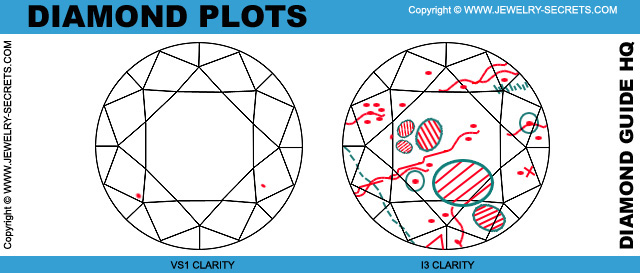
Marks on this diagram show where the inclusions and blemishes are in the diamond. Viewing these diamonds under a scope and rotating the stone to line up the inclusions with the plot will help you understand flaws and bring them to life.
You should be able to spot them better once you know where they are.
Plots like these are like a fingerprint of the diamond. No two diamonds will ever look the same (unless you compare flawless to flawless).
Once you get used to focusing inside the stone and finding the markings you will appreciate nature even more. Perfection is almost impossible.
It’s good to think about diamonds under a scope as a clock. It helps identifying the flaws. The salesperson can say “There’s a pinpoint at the 2 o’clock position” and it helps you pinpoint exactly where it is. Being able to memorize your own diamond inclusions can help you identify them later.
Identify Inclusions to Prevent Diamond Switching!
View your stone under a scope when you drop it off at a jewelry store for repairs, sizings or polishings. View your stone again when you pick it up to make sure you got your diamond back. You’ll be able to view your stone and say “Yes, pinpoint at the 2 o’clock position“… This assures you that you got your diamond back and the jeweler didn’t switch it out for a lower clarity stone. If the store knows you can identify your rock, they’ll be less tempted to switch it. :) See flaws are a good thing.
This is also a good reason to not buy the highest clarities on the market (VVS+)… VVS+ will look flawless to an untrained eye but it makes it very difficult to identify. Is it your stone? Or is it a fake? Fakes are normally clean inside. Would you know the difference?
A VS clarity diamond or an SI clarity diamond will have minor inclusions that make identification easier. The inclusions can be seen under magnification. You can say “Yes, that’s my stone!“
As long as you can’t see any inclusions with the bare eye, and as long as the flaws don’t diminish the beauty or sparkle of the stone, then that’s the clarity to buy.
What do I recommend?
Personally, I love VS diamonds and would greatly advise buying them.
Once you view a VS stone under a microscope and then view an SI or I clarity diamond, I think you’ll fall in love too.
Clarity really is in the eye of the beholder and any clarity SI1 or higher (eye clean diamonds) will make for a great engagement ring diamond. Anything SI2 or lower can still be a good diamond, but they do deserve more scrutiny. The flaws get bigger, more visible and may distract from the beauty of the stone.
You have to decide for yourself, and then you have to see them to appreciate them.
Shop & Compare Clarity
Shop and compare and always, always buy your diamond certified (I prefer GIA). Buying certified guarantees that the diamond you’re looking at is the diamond you’re buying. It makes it easier to compare apples to apples and see which jewelers are really giving you the better deals.
Do note that if it sounds too good to be true, it usually is. Most jewelers are within a couple of hundred dollars of each other if all things are equal. But if one jeweler is $5,000 less…. Beware! There’s a good reason it’s cheaper and it’s usually because of cut.
Cut plays a huge role in how beautiful a diamond is. The better the cut of the diamond, the more sparkle and shine you will get. That sparkle helps hide other flaws and inclusions inside the stone. They all work together. It’s a win-win situation.
With diamonds, clarity is just one of the 4C’s that make up the value of a diamond. Make sure you take everything else into consideration as well. Because any clarity of diamond SI1 or higher will look the same to the bare eye… You’ll need a microscope to spot these small differences.
And whoever is going to carry around a microscope? No one.
Usually the only time you’ll pay this much attention to the diamond is the day you buy it… And of course the day you drop it off at the jewelers to get it sized. :)
Just Remember:
- Scope the stone before and after you get it back.
- View your inclusions.
- Identify your stone.
It’s peace of mind for you, and your jeweler. :)
Now onto the next of the 4C’s:
Cheers! :)


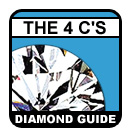
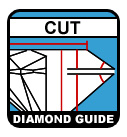
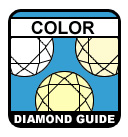
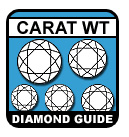
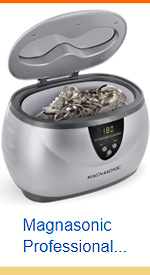

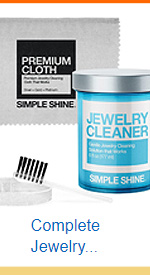
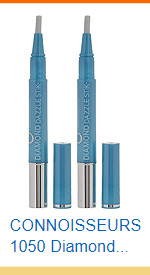
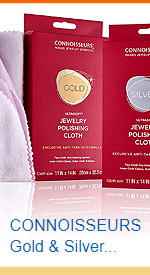
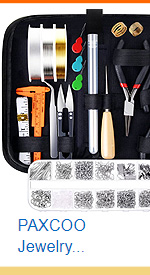
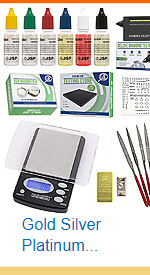
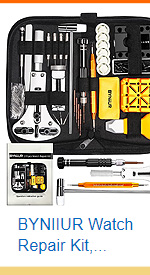
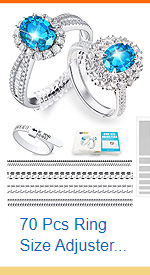
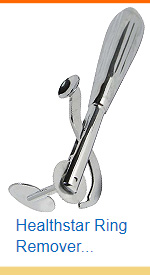
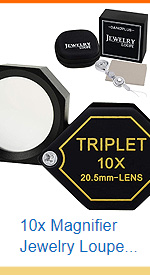
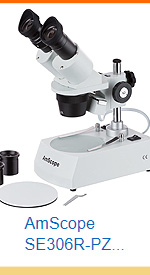




Leave a comment